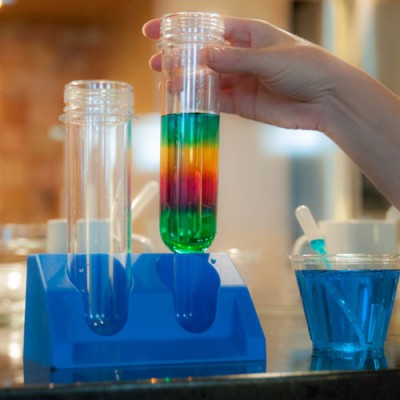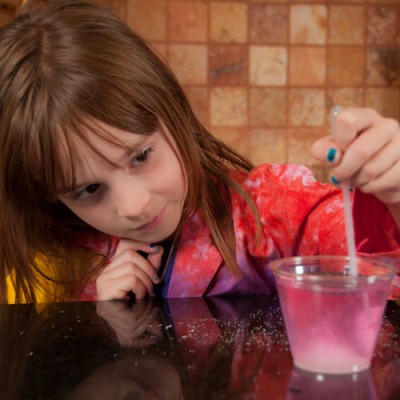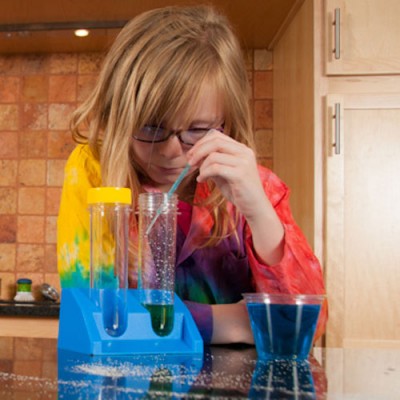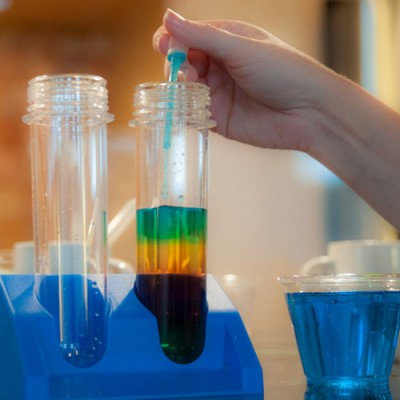Sugar Water Density Towers – Escape the Heat and Experiment in the Kitchen
By Blog Editor Susan Wells
For this week’s Sick Science! Summer Camp we experimented with density using sugar and water. Usually around this time of the summer we are looking for indoor activities to do on a rainy summer day. This summer has been extremely hot and dry across the country. Many areas are facing severe drought situations.
So instead of a rainy day activity, we hunkered down inside to stay out of the midday sun and 100 degree temperatures.
This experiment teaches a lesson in density and supersaturated liquids. Do your children like to dump spoonfuls of sugar into their Kool-Aid or a giant scoop of Gatorade powder into a glass of water like mine do?
Time to take out the sugar and demonstrate what happens when you add 14 spoonfuls of sugar to one small cup of Kool-Aid.
Instead of using Kool-Aid, we used colored water, but either one will work.
For this experiment, everything you will need is found in your kitchen. Hence, the name Kitchen Science, but you knew that. We used materials from Steve Spangler Science, because well you know why. I’ll list the kitchen supplies, but if you are interested in the SSS supplies, visit the Sugar Water Density Tower experiment for a complete list and more of the science behind the activity.
You will need 4 short glasses and one tall, clear glass, a dropper, sugar, water, measuring spoons, and food coloring or Kool-Aid.
Start by filling each glass with about a cup of warm water. The exact amount isn’t as important as each glass having the same amount of water. Then color the water with either food coloring or Kool-Aid. In the first cup, add 2 tablespoons of sugar, in the second add 4 tablespoons of sugar, third add 6 tablespoons of sugar and in the last add 8 tablespoons of sugar. Label each cup with the amount of sugar added. Mix the sugar into the water until it is completely dissolved. If the sugar doesn’t dissolve, the solution is over saturated and you must supersaturate it by heating the water. Place the cup of water in the microwave and heat for 10-20 seconds. Stir again. Repeat the process until the sugar is dissolved.
Once your sugar is dissolved, start by adding the most dense solution to the bottom of your tall glass. Why do you start with the most dense?
Density is mass divided by volume, but what does that mean? Mass is how many atoms are in an object and volume is how much space an object takes up.
Basically, the more sugar in the water, the more sugar molecules are in the space, the more dense the solution.
So start with the most dense cup – the 8 tablespoons. Fill the bottom of the glass at least an inch to two inches high.
Here comes the tricky part. Add the next dense solution – the 6 tablespoons on top of the 8 tablespoons solution. This will take a lot of patience and a steady hand. Place the dropper end right above the water line and against the glass. Start slowing dripping the water droplets onto the first layer. It will take several drops before you start to see a new layer forming.
Look closely and you will see the lesser dense solution dripping into the more dense solution below it and then rising up. The colors may mix a little bit, but keep going, your true color will start to show itself.
Repeat these steps for the remaining colors.
What happens if you mix up your rainbow density tower when you are finished? The sugar will mix evenly into the water and the rainbow will disappear. So be careful!
Now try this experiment with different liquids or mixtures. Will it work with baking soda? Salt? What if you try different ingredients like sugar water, salt water, oil and layer them on top of each other?








Leave a Reply
Want to join the discussion?Feel free to contribute!